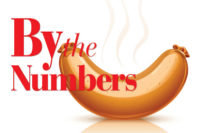Started as a family business in 1962, Frohling Meats Inc., located in Hecla, S.D., purchased its first smokehouse in 1997. The company manufactures a wide range of smoked products and sells an estimated 25 to 30 different products at any one time in Frohling Meats’ two retail stores.
Jon Frohling, the company’s owner, who’s been with the business since 1994, says that he learned smokehouse operation from hiring an experienced operator and from networking through associations. Now, he teaches courses at North Dakota State University and South Dakota State University, and will run a session on summer sausages at the upcoming American Association of Meat Processors conference this July.
Frohling Meats has three smokehouses, with two being gravity-style machines and the newest one being a horizontal-flow, double-cage machine. Frohling says the new machine has 14 screens for jerky instead of the seven that the others have.
“Jerky can kick a processor’s butt,” he explains, “because if you’re making that same house full of summer sausage, you’d have 400 pounds in it, and you’ve only got 45 pounds of jerky. As far as tonnage goes, it costs you a lot of money to make.” The new smokehouse, though, has allowed Frohling Meats to double its jerky production.
Glen Meskimen is a former executive at Iowa Ham, which was acquired by Tyson, and a current industry consultant. He recommends that processors find smokehouses with flexibility, allowing them to modify racks to cook more types of products. Cooking systems that have brine-chill systems are a good option for processors who want to expand their cooked-meat operations.
As far as smokehouses go, Meskimen recommends using atomized liquid smoke instead of natural smoke for improved efficiency.
“There has been a lot of progress in liquid smoke companies,” he says. “They will make you a product that you can atomize in your smokehouse, and you will not be able to tell the difference between actual wood product versus the liquid smoke product.”
The liquid smoke process gives a more consistent covering on the products, he adds, and it still allows a processor to state that the product is naturally hardwood smoked, as the liquid smoke companies make their products from wood.
Frohling cautions processors to look for equipment that can be repaired easily, adding that some German-made equipment is good, but ordering parts can be a hassle.
“I can make these machines run by going to the hardware store,” he says, “My machines, even older ones, were never down for more than a day for repairs.” Little things, like making sure wet socks are changed periodically and checking the humidity levels are keys to making sure a processor gets perfect product every time, Frohling adds.
Meskiman recommends working with suppliers to fine-tune the equipment. Along with the equipment manufacturers, representatives from the liquid smoke and casing companies are also well-versed in smokehouse technology.
“Those people will all help you make a high-quality product at the least possible cost in those houses,” he says.





